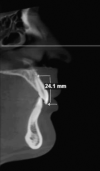A comparative study of the effect of the intrusion arch and straight wire mechanics on incisor root resorption: A randomized, controlled trial
- PMID: 28985106
- PMCID: PMC8315715
- DOI: 10.2319/06417-424R
A comparative study of the effect of the intrusion arch and straight wire mechanics on incisor root resorption: A randomized, controlled trial
Abstract
Objective: To analyze and compare external apical root resorption (EARR) of maxillary incisors treated by intrusion arch or continuous archwire mechanics.
Materials and methods: This cone-beam computed tomography (CBCT) study analyzed 28 deep bite patients in the permanent dentition who were randomly divided into two groups: Group 1, 12 patients with initial mean age of 15.1 ± 1.6 years and mean overbite of 4.6 ± 1.2 mm treated with the Connecticut intrusion arch (CIA) in the upper arch (Ortho Organizers, Carlsbad, Calif) for a mean period of 5.8 ± 1.27 months. Group 2, 16 patients with initial mean age of 22.1 ± 5.7 years and mean overbite of 4.1 ± 1.1 mm treated with conventional leveling and alignment using continuous archwire mechanics for 6.1 ± 0.81 months. The degree of EARR was detected in 112 maxillary incisors by using CBCT scans and a three-dimensional program (Dolphin 11.7, Dolphin Imaging & Management Solutions, Chatsworth, Calif). The CBCT scans were obtained before (T1) and 6 months after initiation of treatment (T2). Differences between and within groups were assessed by nonpaired and paired t-tests, respectively, with a 5% significance level.
Results: Significant differences were found for both groups between T1 and T2 ( P < .05) indicating that EARR occurred in both groups. However, there were no significant differences when EARR was compared between group 1 (-0.76 mm) and group 2 (-0.59 mm).
Conclusions: The Connecticut intrusion arch did not lead to greater EARR of maxillary incisors when compared with conventional orthodontic mechanics.
Keywords: Biomechanics; Intrusion; Overbite; Root resorption; Tomography.
Figures
Comment in
-
Letters From Our Readers.Angle Orthod. 2019 Jan;89(1):163. doi: 10.2319/0003-3219-89.1.163. Angle Orthod. 2019. PMID: 30702940 Free PMC article. No abstract available.
-
Letters From Our Readers.Angle Orthod. 2019 Jan;89(1):164-165. doi: 10.2319/0003-3219-89.1.164. Angle Orthod. 2019. PMID: 30702941 Free PMC article. No abstract available.
Similar articles
-
Evaluation of dentoalveolar changes following maxillary incisor intrusion with one vs two anterior miniscrews in subjects with gummy smile: a randomized clinical trial.Angle Orthod. 2024 Sep 1;94(5):522-531. doi: 10.2319/121323-825.1. Angle Orthod. 2024. PMID: 39230014 Free PMC article. Clinical Trial.
-
Comparative cone-beam computed tomographic evaluation of maxillary incisor intrusion and associated root resorption: Intrusion arch vs mini-implants.Am J Orthod Dentofacial Orthop. 2023 Mar;163(3):e84-e92. doi: 10.1016/j.ajodo.2022.12.007. Epub 2023 Jan 11. Am J Orthod Dentofacial Orthop. 2023. PMID: 36635144
-
Effects of intrusion combined with anterior retraction on apical root resorption.Eur J Orthod. 2012 Apr;34(2):170-5. doi: 10.1093/ejo/cjq178. Epub 2011 Mar 9. Eur J Orthod. 2012. PMID: 21389075
-
A study of the relationship between incisor intrusion and root shortening.Am J Orthod Dentofacial Orthop. 1989 Nov;96(5):390-6. doi: 10.1016/0889-5406(89)90323-5. Am J Orthod Dentofacial Orthop. 1989. PMID: 2683733 Review.
-
Comparison of external apical root resorption with clear aligners and pre-adjusted edgewise appliances in non-extraction cases: a systematic review and meta-analysis.Eur J Orthod. 2021 Jan 29;43(1):15-24. doi: 10.1093/ejo/cjaa013. Eur J Orthod. 2021. PMID: 32077935 Free PMC article.
Cited by
-
Effect of the application of high-frequency mechanical vibration on tooth length concurrent with orthodontic treatment using clear aligners: A retrospective study.J Orthod Sci. 2018 Nov 15;7:20. doi: 10.4103/jos.JOS_53_18. eCollection 2018. J Orthod Sci. 2018. PMID: 30547016 Free PMC article.
-
A prospective clinical trial of the effects produced by the Connecticut intrusion arch on the maxillary dental arch.Angle Orthod. 2020 Jul 1;90(4):500-506. doi: 10.2319/102219-666.1. Angle Orthod. 2020. PMID: 33378499 Free PMC article. Clinical Trial.
-
One versus two anterior miniscrews for correcting upper incisor overbite and angulation: a retrospective comparative study.Prog Orthod. 2020 Sep 7;21(1):34. doi: 10.1186/s40510-020-00336-2. Prog Orthod. 2020. PMID: 32893322 Free PMC article.
-
Letters From Our Readers.Angle Orthod. 2019 Jan;89(1):163. doi: 10.2319/0003-3219-89.1.163. Angle Orthod. 2019. PMID: 30702940 Free PMC article. No abstract available.
-
Displacement in root apex and changes in incisor inclination affect alveolar bone remodeling in adult bimaxillary protrusion patients: a retrospective study.Head Face Med. 2020 Nov 20;16(1):29. doi: 10.1186/s13005-020-00242-2. Head Face Med. 2020. PMID: 33213460 Free PMC article.
References
-
- Burstone CR. Deep overbite correction by intrusion. Am J Orthod. 1977;72:1–22. - PubMed
-
- Nielsen IL. Vertical malocclusions: etiology, development, diagnosis and some aspects of treatment. Angle Orthod. 1991;61:247–260. - PubMed
-
- Nanda R. Correction of deep overbite in adults. Dent Clin North Am. 1997;41(1):67–87. - PubMed
-
- Nanda R. Esthetics and Biomechanics in Orthodontics 2nd ed. St Louis, MO: Elsevier/Saunders;; 2015.
-
- Nanda R, Marzban R, Kuhlberg A. The Connecticut intrusion arch. J Clin Orthod. 1998;32:708–715. - PubMed
Publication types
MeSH terms
LinkOut - more resources
Full Text Sources
Other Literature Sources





